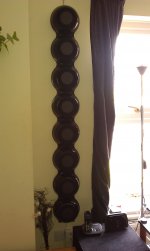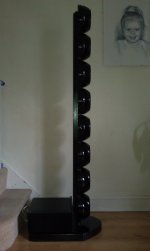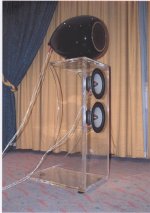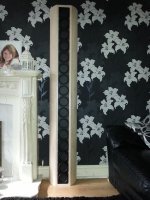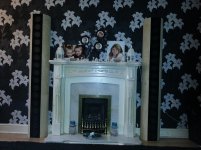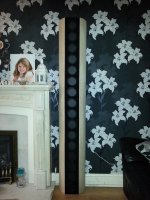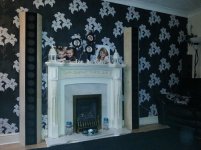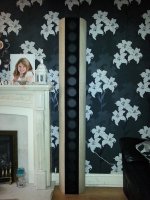I've heard reports that BMR drivers have an inherent disadvantage to their design with respect to stereo imaging. Could others here who have experience with these drivers offer their opinion on this? If that's correct, would this also apply to other drivers which utilise flat cones though which are not BMR? Many thanks.
It depends. Technically 'imaging' doesn't really mean much, but like anything else, there are advantages and disadvantages. All other things being equal (which they rarely if ever are) flat / flatter cone profiles allow for wider off-axis dispersion as frequencies increase, though as usual there are tradeoffs to consider.
Would there be any sense to the assertion that wider dispersion impairs imaging, that somehow less tight and focused dispersion is better in that regard, than having sound be more diffuse and dispersed?
'Imaging' to me is just another word to describe the effect of stereo at its best, all that its ultimately capable of (creating, or re-creating depth and spaciousness, with a placement of elements on a soundstage). In short, it's of great value in my applications.
'Imaging' to me is just another word to describe the effect of stereo at its best, all that its ultimately capable of (creating, or re-creating depth and spaciousness, with a placement of elements on a soundstage). In short, it's of great value in my applications.
Imaging is a red herring. Extremely few recordings use the "single mic" technique, i.e. a single pair of mics. Almost all recordings are multi-mic'd with a mic for each singer and player. Any imaging is the product of post processing. Add to that, most halls don't image anyway. There are too many reflections. IMO imaging is an artifact of listening to the equipment rather than listening to the music.
The best imaging is with two point-source speakers located in an empty field. No reflections. Reflections off of walls, floors, ceilings, furniture, and anything else that we have to live with tend to destroy imaging.
[/rant]
Bob
The best imaging is with two point-source speakers located in an empty field. No reflections. Reflections off of walls, floors, ceilings, furniture, and anything else that we have to live with tend to destroy imaging.
[/rant]
Bob
Perhaps it's just a semantic point on the term "imaging" that's at hand here, but whether or not it is a product of a natural occurrences captured by a single point stereo mic technique (I've made many such recordings) or a constructed image with spacialization created by various means for each recorded instrument (again, years of experience in studio settings) in the end, both yield some kind of dimensional presentation in stereo, and both can impress.
Returning more to the original issue, here's one such mention of how the broad dispersion of flat drivers seems to impact stereo presentation:
6moons audio reviews: Boenicke Audio B10
"...The phenomenal off-axis response of these flat mid/tweeters adds its own 'quasi-extended' crossfeed effect..."
From the description it sounds negative, unless placing the speakers further apart.
Returning more to the original issue, here's one such mention of how the broad dispersion of flat drivers seems to impact stereo presentation:
6moons audio reviews: Boenicke Audio B10
"...The phenomenal off-axis response of these flat mid/tweeters adds its own 'quasi-extended' crossfeed effect..."
From the description it sounds negative, unless placing the speakers further apart.
Last edited:
I don't see anything in the article which supports "broad dispersion of flat drivers". What you see are small drivers on a very narrow baffle. This results in a wide radiation pattern - regardless how "cony" or "flat" the drivers are. If you look at moon's room, there is nothing on the first sidewall reflection points to prevent severe reflections. If he chooses to hype that as 'quasi-extended' crossfeed effect ...Returning more to the original issue, here's one such mention of how the broad dispersion of flat drivers seems to impact stereo presentation:
6moons audio reviews: Boenicke Audio B10
"...The phenomenal off-axis response of these flat mid/tweeters adds its own 'quasi-extended' crossfeed effect..."
With "'quasi-extended' crossfeed effect" it seems the slippery and vague nature of description so typical in audiophile magazine reviews is at work, again. Your points are well taken. In your experience, can you say that a baffle 2-3 wider in this situation would noticeably impact the radiation pattern? If so, then this ultra-narrow face accomplishes what was probably set out in any design brief they may have given themselves. Do you think a 110cm spherical front offer any discernible benefits over the totally flat baffle?
BMR point source plus broad & even off axis
Hi Lucadelcarlo,
Good low distortion pure point source drivers are rare, but the two I have experience with both provide astonishing stable soundstaging and believable imaging.
I have been a long term fan of the Manger driver, used in custom 20Kg "tear drop " enclosure it is a true point source reference above 300Hz or so. Attached is a pic of the "Angel", and acrylic open baffle bass / mid cabinet with the Manger in its "tear drop" enclosure sitting on a 25mm custom Sorbothane support.
More recently the 4.5 inch Neo magnet BMR driver has caught my attention and I am enjoying great sound from the BMR in line array cabinets. Attached a couple of pics of an on wall and free standing line array.
Used as a single point source in a "flat faced rugby ball" or even conical enclosure they are unbeatable desk top monitors or nearfield studio monitors. Two caveat's, low max SPL's...
There is no way round 20 watts max continuous power handling and 89dB / 1 watt sensitivity with a single driver, the max continuous SPL is only going to be around 104dB with around 108dB or maybe 109dB peaks.
Still loud enough for most folks nearfied or in small rooms.
Second caveat, must crossover to bass driver at 150Hz (48dB or higher, octave slope) to 200Hz (min 24dB per octave slope), if you try 80Hz straight to sub its not so pretty!
The good news is that used in 10 or 16 driver line arrays you dont need a sub at all! Genuine full range music with no bass or sub drivers to crossover to.
I Eq flat to 35Hz and have great dynamics with headroom to die for.
The unique broad and even off axis power response of the BMR makes it a perfect choice for line array and the on-wall cabinet design benefits even further from boundary support at low frequencies.
I do encourage you to try a pair, the BMR 's are low cost so its well worth buying a pair and experimenting to judge for your self.
All the best
Derek.
Hi Lucadelcarlo,
Good low distortion pure point source drivers are rare, but the two I have experience with both provide astonishing stable soundstaging and believable imaging.
I have been a long term fan of the Manger driver, used in custom 20Kg "tear drop " enclosure it is a true point source reference above 300Hz or so. Attached is a pic of the "Angel", and acrylic open baffle bass / mid cabinet with the Manger in its "tear drop" enclosure sitting on a 25mm custom Sorbothane support.
More recently the 4.5 inch Neo magnet BMR driver has caught my attention and I am enjoying great sound from the BMR in line array cabinets. Attached a couple of pics of an on wall and free standing line array.
Used as a single point source in a "flat faced rugby ball" or even conical enclosure they are unbeatable desk top monitors or nearfield studio monitors. Two caveat's, low max SPL's...
There is no way round 20 watts max continuous power handling and 89dB / 1 watt sensitivity with a single driver, the max continuous SPL is only going to be around 104dB with around 108dB or maybe 109dB peaks.
Still loud enough for most folks nearfied or in small rooms.
Second caveat, must crossover to bass driver at 150Hz (48dB or higher, octave slope) to 200Hz (min 24dB per octave slope), if you try 80Hz straight to sub its not so pretty!
The good news is that used in 10 or 16 driver line arrays you dont need a sub at all! Genuine full range music with no bass or sub drivers to crossover to.
I Eq flat to 35Hz and have great dynamics with headroom to die for.
The unique broad and even off axis power response of the BMR makes it a perfect choice for line array and the on-wall cabinet design benefits even further from boundary support at low frequencies.
I do encourage you to try a pair, the BMR 's are low cost so its well worth buying a pair and experimenting to judge for your self.
All the best
Derek.
Attachments
Cheers Derek, those are fascinating designs to see – what enclosure materials are used here other than the acrylic? Which BMR is this exactly (the CSS one?) and where are you sourcing them? I'm very curious how this unit compares with the Tangband aluminium flat cones, if anyone can comment...or speculate. Also, what DSP/active crossover equipment have you chosen to use?
Last edited:
I've heard reports that BMR drivers have an inherent disadvantage to their design with respect to stereo imaging. Could others here who have experience with these drivers offer their opinion on this? If that's correct, would this also apply to other drivers which utilise flat cones though which are not BMR? Many thanks.
A few years back I measured the on and off axis response of the Tang Band flat cone driver.
The results were freakish; the driver's sound is virtually the same off axis as it is on-axis.
It was a bit shocking, and it was one of those 'eureka' moments where I started to understand that directivity isn't just about waveguides; you also need to understand what's going on in the loudspeaker cone. (or loudspeaker piston in this case.)
Honestly it's a mystery to me why these aren't more popular. The flat cone definitely sounds and measures differently.
Obviously, there are upsides and downsides to this.
The good:
1) Off axis response is freakishy similar to on-axis. This means a nice wide treble. It's really quite eerie.
2) Potentially a better interface between the face of the cabinet and the driver... Basically the transition from driver to cabinet is only interrupted by the surround.
The bad:
1) The flat cone can create interference with itself. You'll notice this in the measurements; there are dips and peaks which happen because the energy from one side of the cone is out-of-phase with the energy from the other side. In a cone this isn't as much of a problem, because the pathlength from your ear to the loudspeaker center is more closely aligned. (Basically the small increase in distance at the center of the cone helps to equalize the pathlenghts, and that keeps high frequncies in phase, which basically flattens and extends the response in a cone loudspeaker.)
2) A flat cone may not be as strong.
I heard the Naim BMT, the Ovator, at CES. Gorgeous sound.
LA 16 unfinished
Hey Patrick,
If you liked the Naim with 1 BMR, you will love these...16 BMR ( 4.5 inch Neo magnet) per side!
112mm square driver chassis mounted tight edge to edge so 112mm centre to centre. I simply can not hear any peaks / nulls comb filtering effects at any realistic listening distance. even at 1 meter they blend better than a two way stand mount, at 2 or 3 meters they just engulf you in sound.
You are right about imaging, really even everywhere in the room.
Makes Eq'ing easy as it sounds the same off axis as it does in the listening seat.
About a year ago I made an 8 driver per side version using a slightly differend BMR, still great results even with 200mm centre to centre spacing.
Cheers
Derek.
Hey Patrick,
If you liked the Naim with 1 BMR, you will love these...16 BMR ( 4.5 inch Neo magnet) per side!
112mm square driver chassis mounted tight edge to edge so 112mm centre to centre. I simply can not hear any peaks / nulls comb filtering effects at any realistic listening distance. even at 1 meter they blend better than a two way stand mount, at 2 or 3 meters they just engulf you in sound.
You are right about imaging, really even everywhere in the room.
Makes Eq'ing easy as it sounds the same off axis as it does in the listening seat.
About a year ago I made an 8 driver per side version using a slightly differend BMR, still great results even with 200mm centre to centre spacing.
Cheers
Derek.
Attachments
4.5 inch Neo BMR
Hi Colin,
I had to buy a large MOQ of drivers to get the spec and quality I wanted.
The ferrite magnet versions sound muddy and distorted to my ears, the rear wave bounces off the large magnet and straight back through the cone...Out of phase, yugh!
Also the small Sd of the 2 and 3 inch drivers means they have to really pump in and out big time to produce high SPL's. This also adds to the muddy sound and loss of detail, all very stressed.
So for me the 4.5 inch ( Sd 60) Neo magnet is the Goldielocks driver.
I am going to make a range of DIY kits available in a couple of months.
The attached LA 16 's are astonishing, really surprising everyone so far, even me!!
Cheers
Derek.
Hi Colin,
I had to buy a large MOQ of drivers to get the spec and quality I wanted.
The ferrite magnet versions sound muddy and distorted to my ears, the rear wave bounces off the large magnet and straight back through the cone...Out of phase, yugh!
Also the small Sd of the 2 and 3 inch drivers means they have to really pump in and out big time to produce high SPL's. This also adds to the muddy sound and loss of detail, all very stressed.
So for me the 4.5 inch ( Sd 60) Neo magnet is the Goldielocks driver.
I am going to make a range of DIY kits available in a couple of months.
The attached LA 16 's are astonishing, really surprising everyone so far, even me!!
Cheers
Derek.
Attachments
Thanks for the info. This looks a good way to go. Will you be offering the drivers alone?
Neat enclosure design, btw.
And I entirely agree about your comment elsewhere that headroom is a necessary step to getting realistic sound. The last two years I've been using a commercial active speaker which can hit 110dB without effort and makes concert recordings much, much more natural to listen to.
Neat enclosure design, btw.
And I entirely agree about your comment elsewhere that headroom is a necessary step to getting realistic sound. The last two years I've been using a commercial active speaker which can hit 110dB without effort and makes concert recordings much, much more natural to listen to.
BMR Line Array Kits & Drivers
Hi Colin,
Yes I will offer both complete kits and raw driver packages.
I have posted driver prices on another thread as well, here they are again:
1 to 9 - £ 49 each
10 to 19 - £ 45 each
20 to 49 - £ 39 each
50 plus - £ 35 each.
For the LA 16 ( picture attached) a set of 32 drivers will cost £ 1,248
The LA 9 ( 18 drivers) will cost £810, and the 8 drivers for the LA 4 will cost £ 392.
I havn't worked out all the kit options and prices yet, but they will be very high quality with everything included for a really high end result.
The finishing will be up to the customer.
The 4 Ohm, LA 16 is a genuine 100dB for 1 watt @ 1 meter:
So 2 watts gives 103dB,
4 watts gives 106dB,
8 watts gives 109dB,
16 watts gives 112dB
32 watts gives 115dB
64 watts gives 118dB
and 128 watts gives 121dB.
I am able to run a very high current and high power, (140watt into 8 Ohms, 280 watts into 4 Ohms) almost flat out with a lot of music.
Realistic in room peaks of 120dB with average 90 dB SPL, actually sound sooooo much quieter than the meter suggests.
The most common reaction and comment is " I had no idea it was that loud until we tried to talk!"
All the best
Derek.
Hi Colin,
Yes I will offer both complete kits and raw driver packages.
I have posted driver prices on another thread as well, here they are again:
1 to 9 - £ 49 each
10 to 19 - £ 45 each
20 to 49 - £ 39 each
50 plus - £ 35 each.
For the LA 16 ( picture attached) a set of 32 drivers will cost £ 1,248
The LA 9 ( 18 drivers) will cost £810, and the 8 drivers for the LA 4 will cost £ 392.
I havn't worked out all the kit options and prices yet, but they will be very high quality with everything included for a really high end result.
The finishing will be up to the customer.
The 4 Ohm, LA 16 is a genuine 100dB for 1 watt @ 1 meter:
So 2 watts gives 103dB,
4 watts gives 106dB,
8 watts gives 109dB,
16 watts gives 112dB
32 watts gives 115dB
64 watts gives 118dB
and 128 watts gives 121dB.
I am able to run a very high current and high power, (140watt into 8 Ohms, 280 watts into 4 Ohms) almost flat out with a lot of music.
Realistic in room peaks of 120dB with average 90 dB SPL, actually sound sooooo much quieter than the meter suggests.
The most common reaction and comment is " I had no idea it was that loud until we tried to talk!"
All the best
Derek.
Attachments
Last edited:
- Status
- This old topic is closed. If you want to reopen this topic, contact a moderator using the "Report Post" button.
- Home
- Loudspeakers
- Full Range
- Imaging with BMR Drivers
